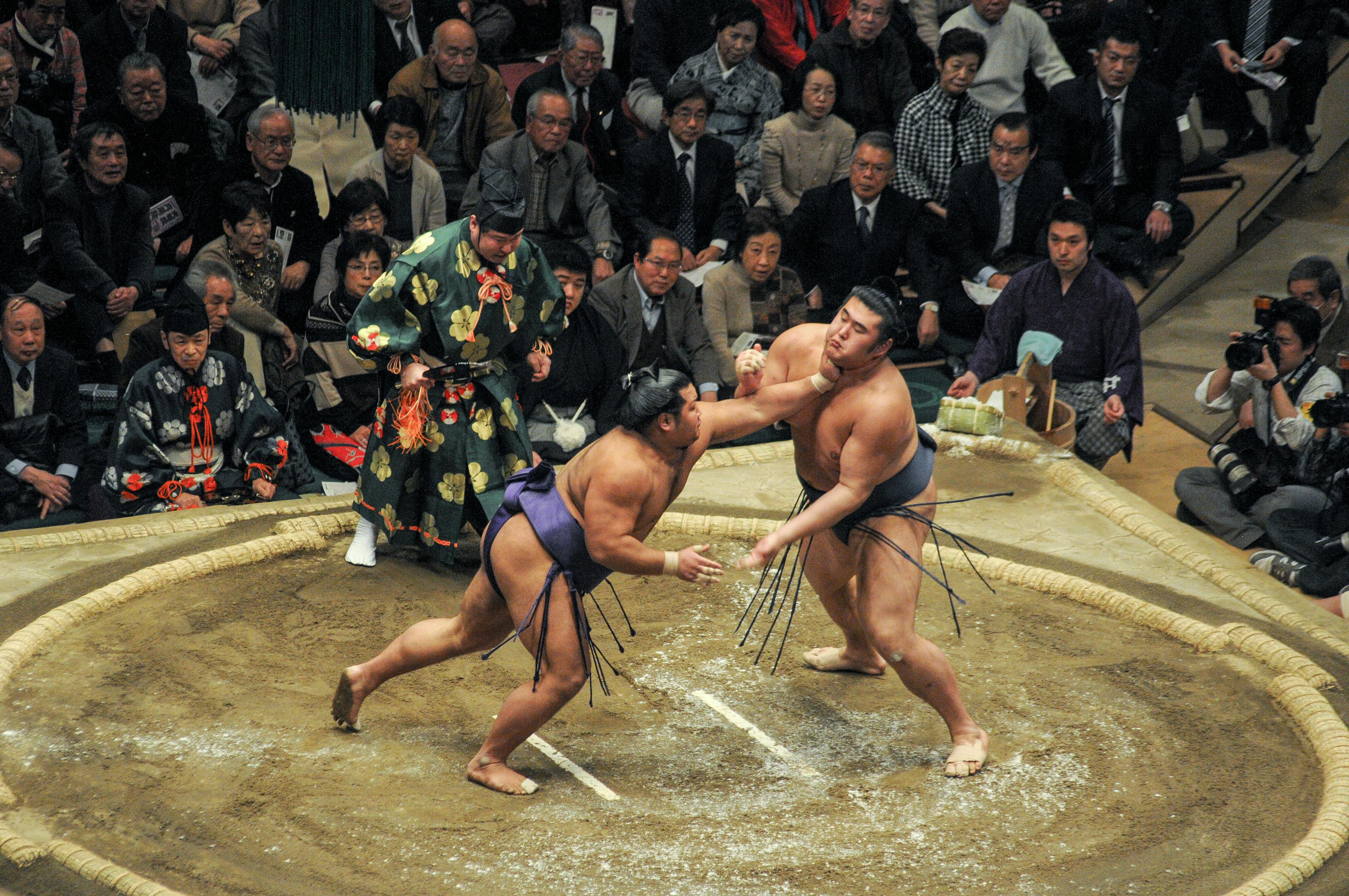Sumo Wrestling: The Art of Balance and Tradition
In the heart of Japan, a sport as old as time itself continues to captivate audiences with its raw power and intricate rituals. Sumo wrestling, a cornerstone of Japanese culture, is more than just two hefty men colliding in a ring. It's a complex dance of strategy, strength, and spirituality that has evolved over centuries. This ancient martial art, steeped in Shinto traditions, offers a unique glimpse into Japan's rich cultural heritage while showcasing the pinnacle of human physical prowess.

As Japan moved into the Edo period (1603-1868), sumo began to take on a more structured form. The dohyo (ring) was introduced, along with many of the rituals we see today. Professional sumo wrestlers, known as rikishi, emerged, and the sport gained popularity among the general public. By the Meiji era (1868-1912), sumo had solidified its position as Japan’s national sport, with the Emperor himself attending tournaments.
Today, sumo retains much of its ancient character while adapting to modern times. The Japan Sumo Association, formed in 1925, oversees all professional sumo activities, maintaining the sport’s integrity and traditions while promoting it on a global scale.
The Anatomy of a Sumo Bout: More Than Meets the Eye
At first glance, a sumo match might seem simple: two large men trying to push each other out of a ring. However, the reality is far more complex. A typical bout, or basho, lasts only a few seconds, but those seconds are the culmination of years of training and centuries of tradition.
Before the actual bout begins, the rikishi engage in a series of pre-match rituals. They enter the ring, perform a ceremonial bow, and engage in shiko, a leg-stomping exercise believed to drive evil spirits from the dohyo. They also throw salt into the ring, a purification ritual with roots in Shinto beliefs.
The match itself begins when both wrestlers touch their fists to the ground simultaneously. From this point, strategy and split-second decision-making become crucial. There are 82 officially recognized winning techniques in sumo, ranging from simple pushouts to complex throws. The bout ends when one wrestler either touches the ground with any part of his body other than the soles of his feet or is forced out of the ring.
What many spectators don’t realize is the immense psychological warfare at play. The pre-bout staredown, known as nirami-ai, can last several minutes, with each wrestler attempting to unnerve his opponent or gain a split-second advantage at the start.
The Life of a Rikishi: Dedication, Discipline, and Chanko Nabe
Becoming a sumo wrestler is not for the faint of heart. Rikishi begin their careers as young as 15, entering a sumo stable where they will live, eat, and train for the rest of their careers. The life of a rikishi is one of strict hierarchy and rigorous discipline.
Training begins before dawn with intense physical exercises, including repeated squats, leg splits, and practice bouts. This is followed by chores around the stable, such as cleaning and cooking. The cornerstone of a rikishi’s diet is chanko nabe, a hearty stew packed with proteins and vegetables, designed to help wrestlers gain and maintain their impressive bulk.
The ranking system in sumo is complex and highly competitive. Wrestlers are divided into six divisions, with the top division, Makuuchi, consisting of just 42 wrestlers. At the pinnacle of the sport are the Yokozuna, grand champions who are expected not only to excel in the ring but also to embody the spirit and values of sumo.
Contrary to popular belief, there is no weight requirement in sumo. While most top-division wrestlers weigh over 300 pounds, some successful rikishi have competed at much lower weights, relying on technique and speed rather than sheer mass.
The Cultural Significance of Sumo: More Than Just Sport
Sumo’s importance in Japanese culture extends far beyond its status as a sport. It is deeply intertwined with Shinto religious practices and Japanese cultural identity. The ring itself is considered a sacred space, purified before each tournament with salt and sake.
Many of the rituals associated with sumo have religious significance. The yokozuna’s ring-entering ceremony, for example, is a Shinto ritual meant to drive away evil spirits. The topknot hairstyle worn by wrestlers is reminiscent of samurai warriors and is seen as a symbol of dignity and honor.
Sumo also plays a role in Japanese diplomacy. It’s not uncommon for visiting dignitaries to be treated to sumo demonstrations, and the sport has been used as a tool for cultural exchange. In recent years, there has been a push to include sumo in the Olympic Games, although this has yet to come to fruition.
Sumo in the Modern Era: Challenges and Innovations
Like many traditional practices, sumo faces challenges in the 21st century. The sport has had to contend with declining interest among young Japanese, who are increasingly drawn to other sports and entertainment options. There have also been controversies, including match-fixing scandals and criticism of the sport’s treatment of women, who are still barred from entering the ring.
However, sumo is evolving to meet these challenges. The Japan Sumo Association has made efforts to promote the sport internationally, leading to an increase in foreign-born wrestlers. Mongolian yokozuna Hakuho, widely considered one of the greatest sumo wrestlers of all time, has helped spark renewed interest in the sport both in Japan and abroad.
Technology is also playing a role in sumo’s modernization. High-speed cameras are now used to review close calls, and social media has allowed fans to connect with their favorite wrestlers in new ways. Some stables have even begun live-streaming morning training sessions, giving fans unprecedented access to the daily lives of rikishi.
The Global Appeal of Sumo: A Universal Language of Sport
While sumo remains quintessentially Japanese, its appeal has spread far beyond the country’s borders. Amateur sumo organizations exist in over 80 countries, and international tournaments attract competitors from around the world. The raw power, strategic depth, and cultural richness of sumo have found resonance with diverse audiences globally.
In Europe, countries like Bulgaria and Estonia have produced successful professional sumo wrestlers. The United States has seen growing interest in amateur sumo, with clubs springing up across the country. Even in regions with no historical connection to sumo, such as Brazil and Africa, the sport has gained a foothold.
This global spread has led to interesting cultural exchanges. Foreign wrestlers bring their own traditions and styles to the dohyo, subtly influencing the evolution of sumo techniques. Conversely, the discipline and philosophy of sumo have inspired athletes in other sports, from mixed martial arts to American football.
The Future of Sumo: Balancing Tradition and Progress
As sumo moves forward, it faces the delicate task of preserving its rich traditions while adapting to a changing world. The sport’s governing body is exploring ways to attract younger fans without alienating its core audience. This includes everything from modernizing tournament venues to experimenting with new formats for amateur competitions.
There’s also a growing focus on the health and well-being of wrestlers. The extreme weight gain required for competitive sumo can lead to health issues later in life, and there are ongoing discussions about how to balance the physical demands of the sport with long-term health considerations.
Environmental sustainability is another area where sumo is making strides. Some tournaments have begun implementing eco-friendly practices, such as using renewable energy sources and reducing plastic waste. This not only aligns with global environmental concerns but also resonates with sumo’s traditional respect for nature.
The Lessons of Sumo: Beyond the Dohyo
The principles embodied in sumo – respect, discipline, and the constant pursuit of self-improvement – offer valuable lessons that extend far beyond the sport itself. In a world often characterized by instant gratification and shortcut seeking, sumo stands as a testament to the power of dedication and perseverance.
For businesses, sumo’s emphasis on tradition balanced with innovation provides a model for maintaining core values while adapting to changing markets. The sport’s focus on mental toughness and strategic thinking under pressure offers insights applicable to various high-stress professions.
In education, the sumo stable system, with its emphasis on mentorship and communal living, presents an alternative model for fostering both individual growth and team cohesion. The sport’s rich cultural associations also make it a valuable tool for teaching Japanese history and culture.
The Enduring Spirit of Sumo
Sumo wrestling, with its unique blend of athleticism, strategy, and cultural significance, continues to captivate audiences worldwide. As it navigates the challenges of the modern era, sumo remains a powerful symbol of Japan’s cultural heritage and a testament to the enduring appeal of traditional sports in a rapidly changing world.
From the thunderous clash of titans in the dohyo to the quiet dedication of young wrestlers in training, sumo embodies a spirit of respect, discipline, and continuous improvement. It reminds us that in sport, as in life, true mastery comes not just from physical prowess, but from the harmonious balance of body, mind, and spirit.
As we look to the future, sumo stands poised to continue its evolution, embracing new audiences and technologies while remaining true to its ancient roots. In doing so, it offers not just thrilling competition, but a window into a philosophy of life that has much to teach us all, regardless of our culture or background.





